Assessment 3 of 3 - Working in the Industry
VerifiedAdded on 2023/06/15
|9
|3437
|452
AI Summary
This assessment focuses on managing all aspects of a meeting, including related communications, and how to ensure all relevant issues are covered in the meeting. It also covers how to contribute to workplace improvements and how workplace meetings contribute to continuing professional development.
Contribute Materials
Your contribution can guide someone’s learning journey. Share your
documents today.

33580/03 E1031BT CHC40413 Certificate IV in Youth Work Page 1 of 9
Student Name:
Student ID:
Short Answer Questions
33580/03 Short answer
E1031BT
Certificate IV in Youth Work
Module 6: Working in the
industry
This is assessment 3 of 3.
1. Background/Overview
Working in the health and community services industry means
dealing with a wide range of people in a wide range of settings.
Workers must know, understand and follow the policies and
procedures that apply in their workplace so they make informed
decisions that are in the best interests of the people in their care
and the organisation itself.
Sometimes workers in the health and community services industry
will come into contact with people who are seeking help who are in
distress and/or not able to communicate their needs clearly. This
may be due to one or more ‘communication barriers’ including the
state of mind or language or cultural differences of the person
seeking help. In all cases, it is very important that workers follow the
organisation’s policies and procedures and if they are unsure about
anything, that they ask a more senior/ experienced member of staff
for their advice before any decisions are made.
2. Brief
This assessment follows on from assessment number two.
Remember you met Joyce, a Chinese woman and Amy, her niece
seeking help from the local PCYC. Amy is depressed, her aunt says
she is not going to school and accuses her of drinking. The PCYC
doesn’t provide residential care yet Susan, the worker from the
PCYC is concerned for Amy's welfare.
Susan and Irene (PCYC) are talking to Amy and Joyce and
suggested referring Amy to an adolescent mental health crisis
team.
Eventually an adolescent mental health crisis team are called and
Amy is taken to be assessed at a secure adolescent unit.
Your understanding of how to manage all aspects of a meeting,
including the related communications, will be established in the
assessment as we follow Amy though the remainder of the
scenario.
Deliverables
This assessment will be submitted in
Word doc format.
To do list:
1. Read the Background/ Overview
and Brief sections of this
document.
2. Read the sections of the case
study and answer the questions
that follow each part of the case
study.
3. Save the Word document using
the naming convention: [your
student
number]_[assessment]_[assessme
nt number].doc. For example:
“12345678_31135_01.doc.”
4. Upload your document in Open
Space using the relevant
Assessment Upload link in this
Study Period.
Student Name:
Student ID:
Short Answer Questions
33580/03 Short answer
E1031BT
Certificate IV in Youth Work
Module 6: Working in the
industry
This is assessment 3 of 3.
1. Background/Overview
Working in the health and community services industry means
dealing with a wide range of people in a wide range of settings.
Workers must know, understand and follow the policies and
procedures that apply in their workplace so they make informed
decisions that are in the best interests of the people in their care
and the organisation itself.
Sometimes workers in the health and community services industry
will come into contact with people who are seeking help who are in
distress and/or not able to communicate their needs clearly. This
may be due to one or more ‘communication barriers’ including the
state of mind or language or cultural differences of the person
seeking help. In all cases, it is very important that workers follow the
organisation’s policies and procedures and if they are unsure about
anything, that they ask a more senior/ experienced member of staff
for their advice before any decisions are made.
2. Brief
This assessment follows on from assessment number two.
Remember you met Joyce, a Chinese woman and Amy, her niece
seeking help from the local PCYC. Amy is depressed, her aunt says
she is not going to school and accuses her of drinking. The PCYC
doesn’t provide residential care yet Susan, the worker from the
PCYC is concerned for Amy's welfare.
Susan and Irene (PCYC) are talking to Amy and Joyce and
suggested referring Amy to an adolescent mental health crisis
team.
Eventually an adolescent mental health crisis team are called and
Amy is taken to be assessed at a secure adolescent unit.
Your understanding of how to manage all aspects of a meeting,
including the related communications, will be established in the
assessment as we follow Amy though the remainder of the
scenario.
Deliverables
This assessment will be submitted in
Word doc format.
To do list:
1. Read the Background/ Overview
and Brief sections of this
document.
2. Read the sections of the case
study and answer the questions
that follow each part of the case
study.
3. Save the Word document using
the naming convention: [your
student
number]_[assessment]_[assessme
nt number].doc. For example:
“12345678_31135_01.doc.”
4. Upload your document in Open
Space using the relevant
Assessment Upload link in this
Study Period.
Secure Best Marks with AI Grader
Need help grading? Try our AI Grader for instant feedback on your assignments.
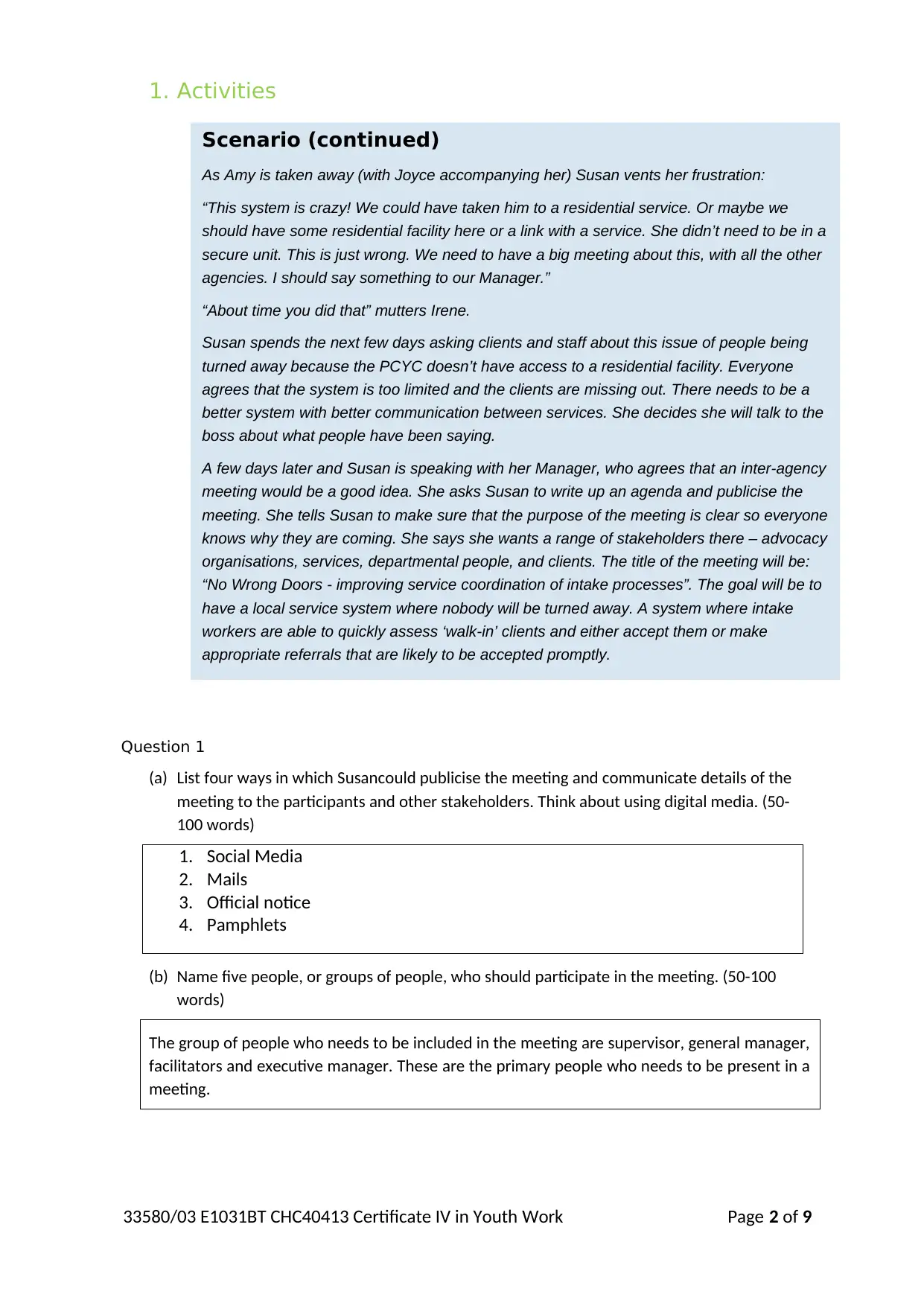
1. Activities
Scenario (continued)
As Amy is taken away (with Joyce accompanying her) Susan vents her frustration:
“This system is crazy! We could have taken him to a residential service. Or maybe we
should have some residential facility here or a link with a service. She didn’t need to be in a
secure unit. This is just wrong. We need to have a big meeting about this, with all the other
agencies. I should say something to our Manager.”
“About time you did that” mutters Irene.
Susan spends the next few days asking clients and staff about this issue of people being
turned away because the PCYC doesn’t have access to a residential facility. Everyone
agrees that the system is too limited and the clients are missing out. There needs to be a
better system with better communication between services. She decides she will talk to the
boss about what people have been saying.
A few days later and Susan is speaking with her Manager, who agrees that an inter-agency
meeting would be a good idea. She asks Susan to write up an agenda and publicise the
meeting. She tells Susan to make sure that the purpose of the meeting is clear so everyone
knows why they are coming. She says she wants a range of stakeholders there – advocacy
organisations, services, departmental people, and clients. The title of the meeting will be:
“No Wrong Doors - improving service coordination of intake processes”. The goal will be to
have a local service system where nobody will be turned away. A system where intake
workers are able to quickly assess ‘walk-in’ clients and either accept them or make
appropriate referrals that are likely to be accepted promptly.
Question 1
(a) List four ways in which Susancould publicise the meeting and communicate details of the
meeting to the participants and other stakeholders. Think about using digital media. (50-
100 words)
1. Social Media
2. Mails
3. Official notice
4. Pamphlets
(b) Name five people, or groups of people, who should participate in the meeting. (50-100
words)
The group of people who needs to be included in the meeting are supervisor, general manager,
facilitators and executive manager. These are the primary people who needs to be present in a
meeting.
33580/03 E1031BT CHC40413 Certificate IV in Youth Work Page 2 of 9
Scenario (continued)
As Amy is taken away (with Joyce accompanying her) Susan vents her frustration:
“This system is crazy! We could have taken him to a residential service. Or maybe we
should have some residential facility here or a link with a service. She didn’t need to be in a
secure unit. This is just wrong. We need to have a big meeting about this, with all the other
agencies. I should say something to our Manager.”
“About time you did that” mutters Irene.
Susan spends the next few days asking clients and staff about this issue of people being
turned away because the PCYC doesn’t have access to a residential facility. Everyone
agrees that the system is too limited and the clients are missing out. There needs to be a
better system with better communication between services. She decides she will talk to the
boss about what people have been saying.
A few days later and Susan is speaking with her Manager, who agrees that an inter-agency
meeting would be a good idea. She asks Susan to write up an agenda and publicise the
meeting. She tells Susan to make sure that the purpose of the meeting is clear so everyone
knows why they are coming. She says she wants a range of stakeholders there – advocacy
organisations, services, departmental people, and clients. The title of the meeting will be:
“No Wrong Doors - improving service coordination of intake processes”. The goal will be to
have a local service system where nobody will be turned away. A system where intake
workers are able to quickly assess ‘walk-in’ clients and either accept them or make
appropriate referrals that are likely to be accepted promptly.
Question 1
(a) List four ways in which Susancould publicise the meeting and communicate details of the
meeting to the participants and other stakeholders. Think about using digital media. (50-
100 words)
1. Social Media
2. Mails
3. Official notice
4. Pamphlets
(b) Name five people, or groups of people, who should participate in the meeting. (50-100
words)
The group of people who needs to be included in the meeting are supervisor, general manager,
facilitators and executive manager. These are the primary people who needs to be present in a
meeting.
33580/03 E1031BT CHC40413 Certificate IV in Youth Work Page 2 of 9

(c) List at least 5 items, or objectives, that should be on a typical meeting agenda. (50-100
words)
Items for a meeting agenda: (objectives)
1) To improve the quality of service
2) To provide effective and emergency solutions
3) To help the community people with necessary support
4) To reduce the number of complain against the organization
5) To establish effective and appropriate communication
Items for a meeting agenda: (items)
1) White board
2) Marker
3) Projector
4) Required Database
5) Pen and Paper
(d) Why is it important for Susan to record aspects of the meeting? Think about legal
requirements, and written correspondence protocols. (50-100 words)
(e) How can Susan encourage others to contribute to, and follow, the meeting objectives and
agenda?(50-100 words)
33580/03 E1031BT CHC40413 Certificate IV in Youth Work Page 3 of 9
Susan can pass the importance of holding the meeting regarding the welfare of
Amy by casual communication with other employees. In addition, Susan can
present some examples of such cases as Amy to reflect the current condition of her
which can be effective to motivate others involve in the meeting.
The importance of the recording of aspects of the meeting lies in the legal
consideration of the matter. To avoid any legal hazards, the minutes of meeting
needs to be recorded. In addition, it comes under the correspondence protocol to
write down the minutes of meeting for further use and help.
words)
Items for a meeting agenda: (objectives)
1) To improve the quality of service
2) To provide effective and emergency solutions
3) To help the community people with necessary support
4) To reduce the number of complain against the organization
5) To establish effective and appropriate communication
Items for a meeting agenda: (items)
1) White board
2) Marker
3) Projector
4) Required Database
5) Pen and Paper
(d) Why is it important for Susan to record aspects of the meeting? Think about legal
requirements, and written correspondence protocols. (50-100 words)
(e) How can Susan encourage others to contribute to, and follow, the meeting objectives and
agenda?(50-100 words)
33580/03 E1031BT CHC40413 Certificate IV in Youth Work Page 3 of 9
Susan can pass the importance of holding the meeting regarding the welfare of
Amy by casual communication with other employees. In addition, Susan can
present some examples of such cases as Amy to reflect the current condition of her
which can be effective to motivate others involve in the meeting.
The importance of the recording of aspects of the meeting lies in the legal
consideration of the matter. To avoid any legal hazards, the minutes of meeting
needs to be recorded. In addition, it comes under the correspondence protocol to
write down the minutes of meeting for further use and help.
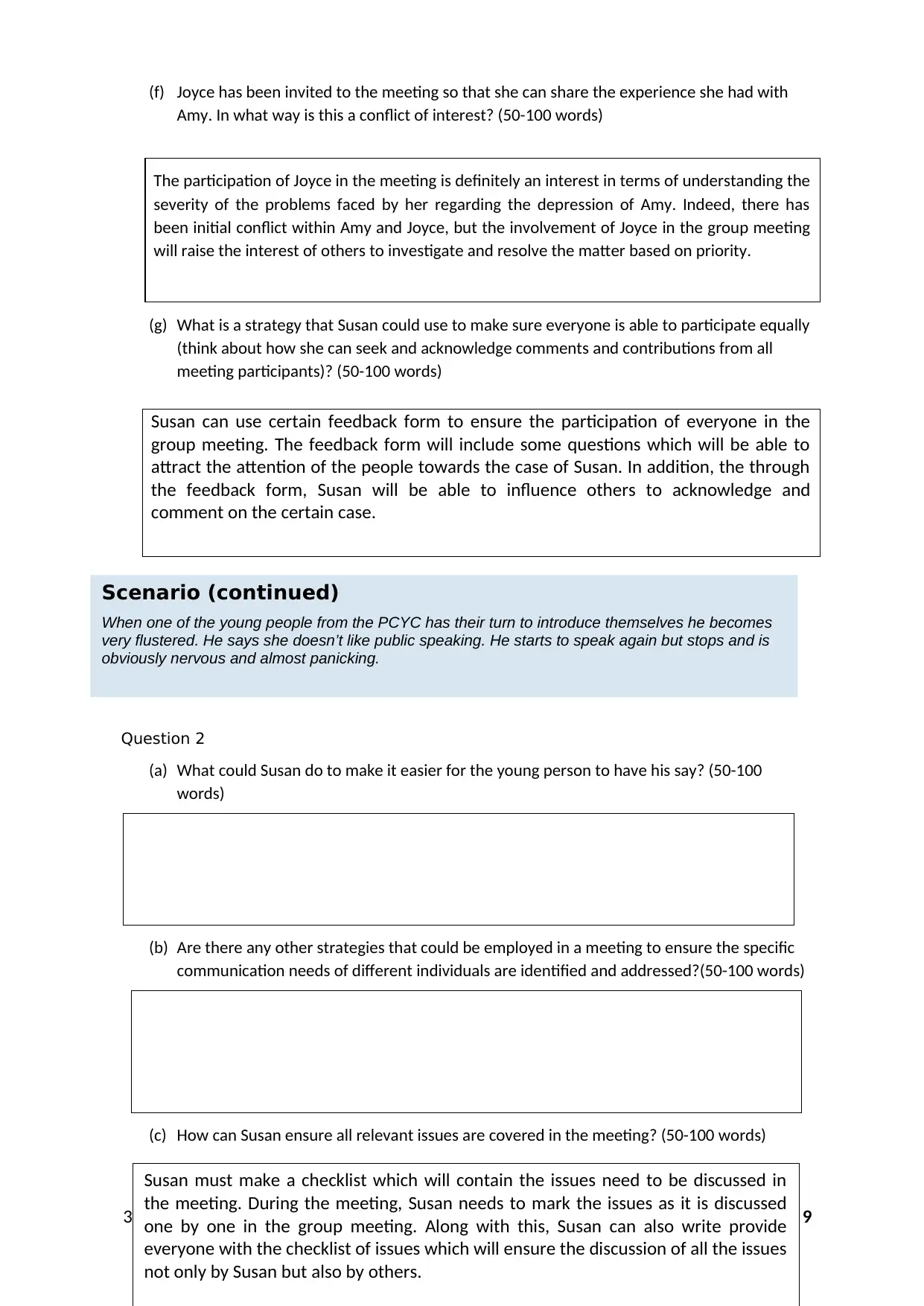
(f) Joyce has been invited to the meeting so that she can share the experience she had with
Amy. In what way is this a conflict of interest? (50-100 words)
The participation of Joyce in the meeting is definitely an interest in terms of understanding the
severity of the problems faced by her regarding the depression of Amy. Indeed, there has
been initial conflict within Amy and Joyce, but the involvement of Joyce in the group meeting
will raise the interest of others to investigate and resolve the matter based on priority.
(g) What is a strategy that Susan could use to make sure everyone is able to participate equally
(think about how she can seek and acknowledge comments and contributions from all
meeting participants)? (50-100 words)
Susan can use certain feedback form to ensure the participation of everyone in the
group meeting. The feedback form will include some questions which will be able to
attract the attention of the people towards the case of Susan. In addition, the through
the feedback form, Susan will be able to influence others to acknowledge and
comment on the certain case.
Question 2
(a) What could Susan do to make it easier for the young person to have his say? (50-100
words)
(b) Are there any other strategies that could be employed in a meeting to ensure the specific
communication needs of different individuals are identified and addressed?(50-100 words)
(c) How can Susan ensure all relevant issues are covered in the meeting? (50-100 words)
33580/03 E1031BT CHC40413 Certificate IV in Youth Work Page 4 of 9
Susan must make a checklist which will contain the issues need to be discussed in
the meeting. During the meeting, Susan needs to mark the issues as it is discussed
one by one in the group meeting. Along with this, Susan can also write provide
everyone with the checklist of issues which will ensure the discussion of all the issues
not only by Susan but also by others.
Scenario (continued)
When one of the young people from the PCYC has their turn to introduce themselves he becomes
very flustered. He says she doesn’t like public speaking. He starts to speak again but stops and is
obviously nervous and almost panicking.
Amy. In what way is this a conflict of interest? (50-100 words)
The participation of Joyce in the meeting is definitely an interest in terms of understanding the
severity of the problems faced by her regarding the depression of Amy. Indeed, there has
been initial conflict within Amy and Joyce, but the involvement of Joyce in the group meeting
will raise the interest of others to investigate and resolve the matter based on priority.
(g) What is a strategy that Susan could use to make sure everyone is able to participate equally
(think about how she can seek and acknowledge comments and contributions from all
meeting participants)? (50-100 words)
Susan can use certain feedback form to ensure the participation of everyone in the
group meeting. The feedback form will include some questions which will be able to
attract the attention of the people towards the case of Susan. In addition, the through
the feedback form, Susan will be able to influence others to acknowledge and
comment on the certain case.
Question 2
(a) What could Susan do to make it easier for the young person to have his say? (50-100
words)
(b) Are there any other strategies that could be employed in a meeting to ensure the specific
communication needs of different individuals are identified and addressed?(50-100 words)
(c) How can Susan ensure all relevant issues are covered in the meeting? (50-100 words)
33580/03 E1031BT CHC40413 Certificate IV in Youth Work Page 4 of 9
Susan must make a checklist which will contain the issues need to be discussed in
the meeting. During the meeting, Susan needs to mark the issues as it is discussed
one by one in the group meeting. Along with this, Susan can also write provide
everyone with the checklist of issues which will ensure the discussion of all the issues
not only by Susan but also by others.
Scenario (continued)
When one of the young people from the PCYC has their turn to introduce themselves he becomes
very flustered. He says she doesn’t like public speaking. He starts to speak again but stops and is
obviously nervous and almost panicking.
Secure Best Marks with AI Grader
Need help grading? Try our AI Grader for instant feedback on your assignments.
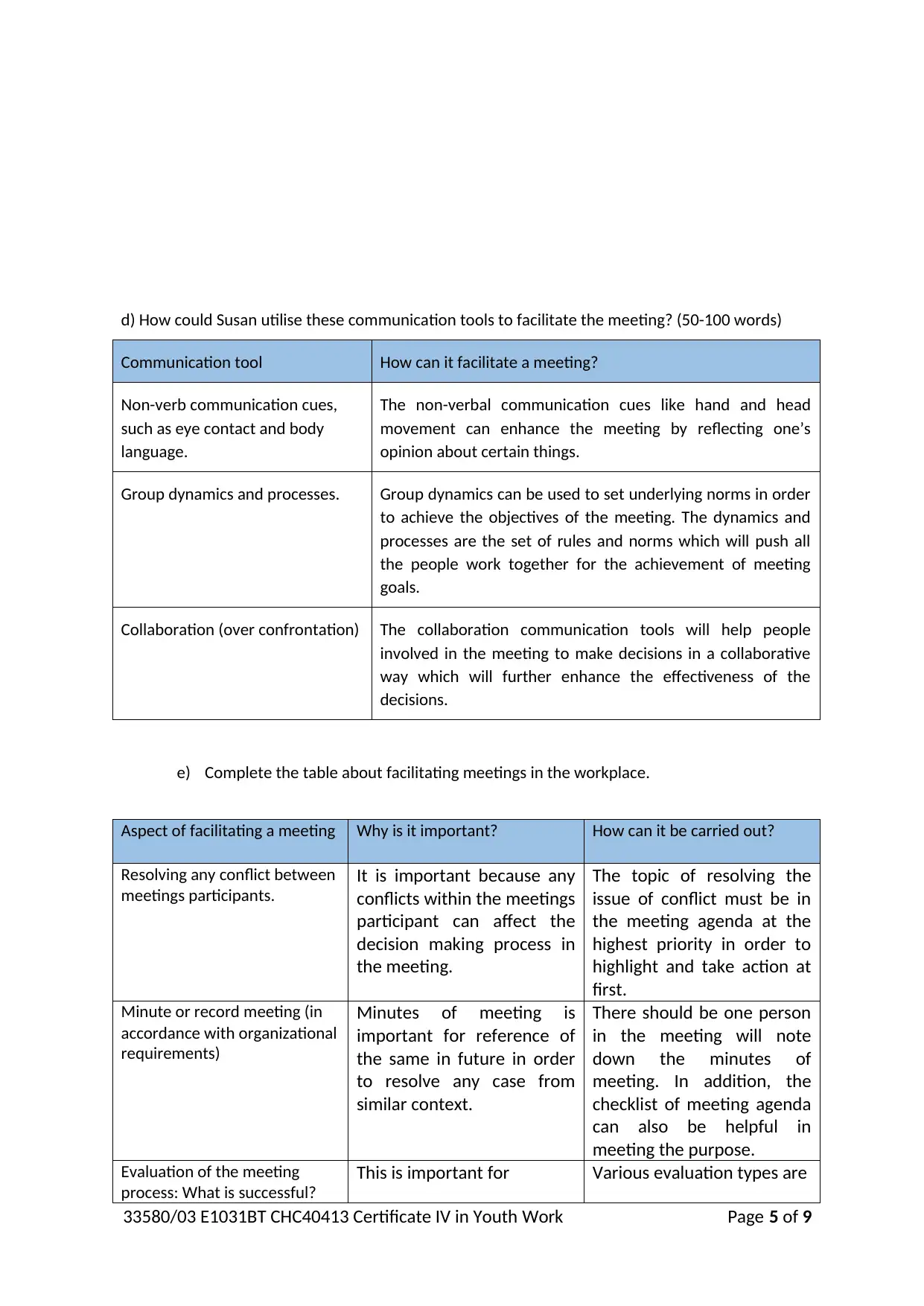
d) How could Susan utilise these communication tools to facilitate the meeting? (50-100 words)
Communication tool How can it facilitate a meeting?
Non-verb communication cues,
such as eye contact and body
language.
The non-verbal communication cues like hand and head
movement can enhance the meeting by reflecting one’s
opinion about certain things.
Group dynamics and processes. Group dynamics can be used to set underlying norms in order
to achieve the objectives of the meeting. The dynamics and
processes are the set of rules and norms which will push all
the people work together for the achievement of meeting
goals.
Collaboration (over confrontation) The collaboration communication tools will help people
involved in the meeting to make decisions in a collaborative
way which will further enhance the effectiveness of the
decisions.
e) Complete the table about facilitating meetings in the workplace.
Aspect of facilitating a meeting Why is it important? How can it be carried out?
Resolving any conflict between
meetings participants.
It is important because any
conflicts within the meetings
participant can affect the
decision making process in
the meeting.
The topic of resolving the
issue of conflict must be in
the meeting agenda at the
highest priority in order to
highlight and take action at
first.
Minute or record meeting (in
accordance with organizational
requirements)
Minutes of meeting is
important for reference of
the same in future in order
to resolve any case from
similar context.
There should be one person
in the meeting will note
down the minutes of
meeting. In addition, the
checklist of meeting agenda
can also be helpful in
meeting the purpose.
Evaluation of the meeting
process: What is successful?
This is important for Various evaluation types are
33580/03 E1031BT CHC40413 Certificate IV in Youth Work Page 5 of 9
Communication tool How can it facilitate a meeting?
Non-verb communication cues,
such as eye contact and body
language.
The non-verbal communication cues like hand and head
movement can enhance the meeting by reflecting one’s
opinion about certain things.
Group dynamics and processes. Group dynamics can be used to set underlying norms in order
to achieve the objectives of the meeting. The dynamics and
processes are the set of rules and norms which will push all
the people work together for the achievement of meeting
goals.
Collaboration (over confrontation) The collaboration communication tools will help people
involved in the meeting to make decisions in a collaborative
way which will further enhance the effectiveness of the
decisions.
e) Complete the table about facilitating meetings in the workplace.
Aspect of facilitating a meeting Why is it important? How can it be carried out?
Resolving any conflict between
meetings participants.
It is important because any
conflicts within the meetings
participant can affect the
decision making process in
the meeting.
The topic of resolving the
issue of conflict must be in
the meeting agenda at the
highest priority in order to
highlight and take action at
first.
Minute or record meeting (in
accordance with organizational
requirements)
Minutes of meeting is
important for reference of
the same in future in order
to resolve any case from
similar context.
There should be one person
in the meeting will note
down the minutes of
meeting. In addition, the
checklist of meeting agenda
can also be helpful in
meeting the purpose.
Evaluation of the meeting
process: What is successful?
This is important for Various evaluation types are
33580/03 E1031BT CHC40413 Certificate IV in Youth Work Page 5 of 9
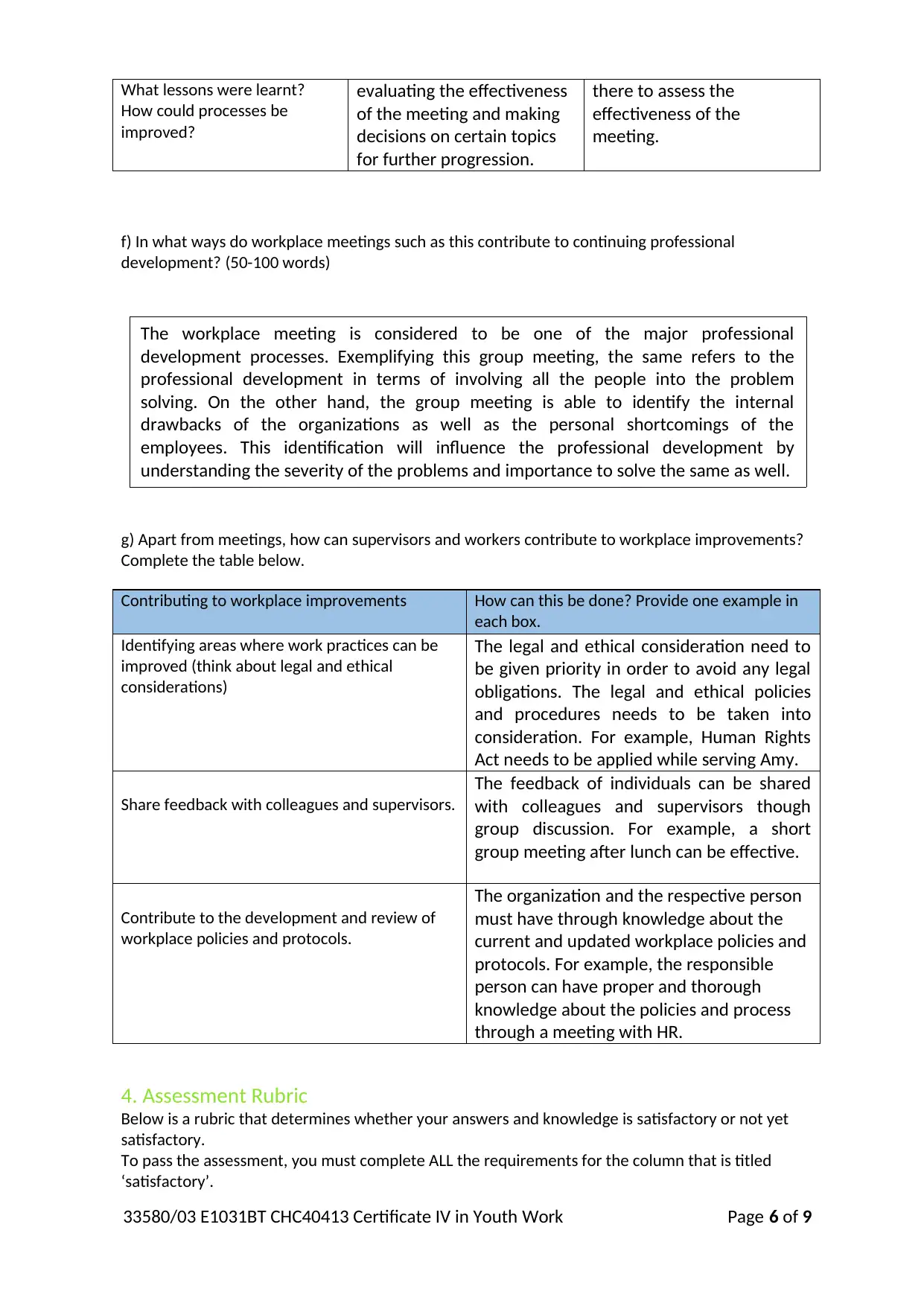
What lessons were learnt?
How could processes be
improved?
evaluating the effectiveness
of the meeting and making
decisions on certain topics
for further progression.
there to assess the
effectiveness of the
meeting.
f) In what ways do workplace meetings such as this contribute to continuing professional
development? (50-100 words)
g) Apart from meetings, how can supervisors and workers contribute to workplace improvements?
Complete the table below.
Contributing to workplace improvements How can this be done? Provide one example in
each box.
Identifying areas where work practices can be
improved (think about legal and ethical
considerations)
The legal and ethical consideration need to
be given priority in order to avoid any legal
obligations. The legal and ethical policies
and procedures needs to be taken into
consideration. For example, Human Rights
Act needs to be applied while serving Amy.
Share feedback with colleagues and supervisors.
The feedback of individuals can be shared
with colleagues and supervisors though
group discussion. For example, a short
group meeting after lunch can be effective.
Contribute to the development and review of
workplace policies and protocols.
The organization and the respective person
must have through knowledge about the
current and updated workplace policies and
protocols. For example, the responsible
person can have proper and thorough
knowledge about the policies and process
through a meeting with HR.
4. Assessment Rubric
Below is a rubric that determines whether your answers and knowledge is satisfactory or not yet
satisfactory.
To pass the assessment, you must complete ALL the requirements for the column that is titled
‘satisfactory’.
33580/03 E1031BT CHC40413 Certificate IV in Youth Work Page 6 of 9
The workplace meeting is considered to be one of the major professional
development processes. Exemplifying this group meeting, the same refers to the
professional development in terms of involving all the people into the problem
solving. On the other hand, the group meeting is able to identify the internal
drawbacks of the organizations as well as the personal shortcomings of the
employees. This identification will influence the professional development by
understanding the severity of the problems and importance to solve the same as well.
How could processes be
improved?
evaluating the effectiveness
of the meeting and making
decisions on certain topics
for further progression.
there to assess the
effectiveness of the
meeting.
f) In what ways do workplace meetings such as this contribute to continuing professional
development? (50-100 words)
g) Apart from meetings, how can supervisors and workers contribute to workplace improvements?
Complete the table below.
Contributing to workplace improvements How can this be done? Provide one example in
each box.
Identifying areas where work practices can be
improved (think about legal and ethical
considerations)
The legal and ethical consideration need to
be given priority in order to avoid any legal
obligations. The legal and ethical policies
and procedures needs to be taken into
consideration. For example, Human Rights
Act needs to be applied while serving Amy.
Share feedback with colleagues and supervisors.
The feedback of individuals can be shared
with colleagues and supervisors though
group discussion. For example, a short
group meeting after lunch can be effective.
Contribute to the development and review of
workplace policies and protocols.
The organization and the respective person
must have through knowledge about the
current and updated workplace policies and
protocols. For example, the responsible
person can have proper and thorough
knowledge about the policies and process
through a meeting with HR.
4. Assessment Rubric
Below is a rubric that determines whether your answers and knowledge is satisfactory or not yet
satisfactory.
To pass the assessment, you must complete ALL the requirements for the column that is titled
‘satisfactory’.
33580/03 E1031BT CHC40413 Certificate IV in Youth Work Page 6 of 9
The workplace meeting is considered to be one of the major professional
development processes. Exemplifying this group meeting, the same refers to the
professional development in terms of involving all the people into the problem
solving. On the other hand, the group meeting is able to identify the internal
drawbacks of the organizations as well as the personal shortcomings of the
employees. This identification will influence the professional development by
understanding the severity of the problems and importance to solve the same as well.
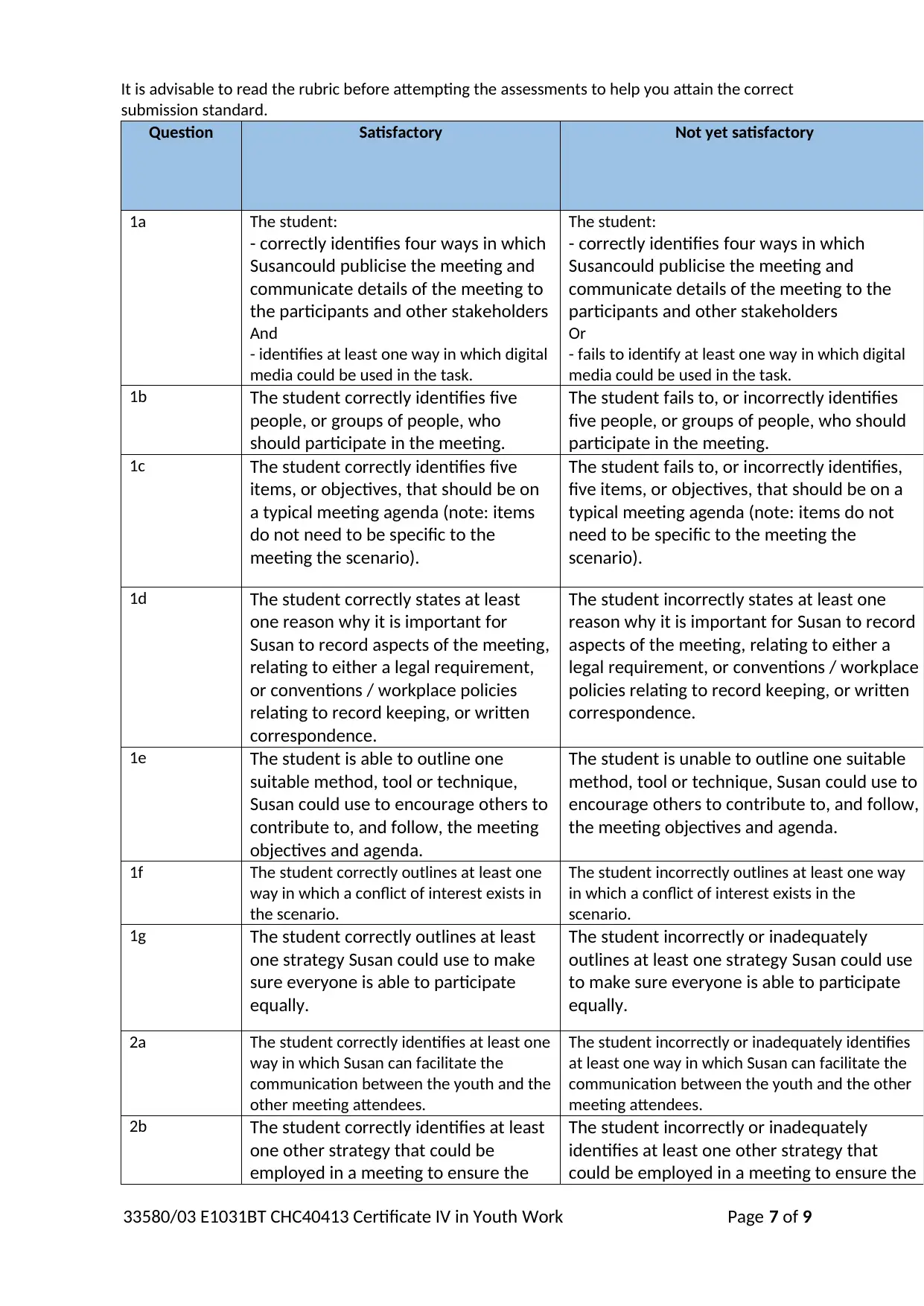
It is advisable to read the rubric before attempting the assessments to help you attain the correct
submission standard.
Question Satisfactory Not yet satisfactory
1a The student:
- correctly identifies four ways in which
Susancould publicise the meeting and
communicate details of the meeting to
the participants and other stakeholders
And
- identifies at least one way in which digital
media could be used in the task.
The student:
- correctly identifies four ways in which
Susancould publicise the meeting and
communicate details of the meeting to the
participants and other stakeholders
Or
- fails to identify at least one way in which digital
media could be used in the task.
1b The student correctly identifies five
people, or groups of people, who
should participate in the meeting.
The student fails to, or incorrectly identifies
five people, or groups of people, who should
participate in the meeting.
1c The student correctly identifies five
items, or objectives, that should be on
a typical meeting agenda (note: items
do not need to be specific to the
meeting the scenario).
The student fails to, or incorrectly identifies,
five items, or objectives, that should be on a
typical meeting agenda (note: items do not
need to be specific to the meeting the
scenario).
1d The student correctly states at least
one reason why it is important for
Susan to record aspects of the meeting,
relating to either a legal requirement,
or conventions / workplace policies
relating to record keeping, or written
correspondence.
The student incorrectly states at least one
reason why it is important for Susan to record
aspects of the meeting, relating to either a
legal requirement, or conventions / workplace
policies relating to record keeping, or written
correspondence.
1e The student is able to outline one
suitable method, tool or technique,
Susan could use to encourage others to
contribute to, and follow, the meeting
objectives and agenda.
The student is unable to outline one suitable
method, tool or technique, Susan could use to
encourage others to contribute to, and follow,
the meeting objectives and agenda.
1f The student correctly outlines at least one
way in which a conflict of interest exists in
the scenario.
The student incorrectly outlines at least one way
in which a conflict of interest exists in the
scenario.
1g The student correctly outlines at least
one strategy Susan could use to make
sure everyone is able to participate
equally.
The student incorrectly or inadequately
outlines at least one strategy Susan could use
to make sure everyone is able to participate
equally.
2a The student correctly identifies at least one
way in which Susan can facilitate the
communication between the youth and the
other meeting attendees.
The student incorrectly or inadequately identifies
at least one way in which Susan can facilitate the
communication between the youth and the other
meeting attendees.
2b The student correctly identifies at least
one other strategy that could be
employed in a meeting to ensure the
The student incorrectly or inadequately
identifies at least one other strategy that
could be employed in a meeting to ensure the
33580/03 E1031BT CHC40413 Certificate IV in Youth Work Page 7 of 9
submission standard.
Question Satisfactory Not yet satisfactory
1a The student:
- correctly identifies four ways in which
Susancould publicise the meeting and
communicate details of the meeting to
the participants and other stakeholders
And
- identifies at least one way in which digital
media could be used in the task.
The student:
- correctly identifies four ways in which
Susancould publicise the meeting and
communicate details of the meeting to the
participants and other stakeholders
Or
- fails to identify at least one way in which digital
media could be used in the task.
1b The student correctly identifies five
people, or groups of people, who
should participate in the meeting.
The student fails to, or incorrectly identifies
five people, or groups of people, who should
participate in the meeting.
1c The student correctly identifies five
items, or objectives, that should be on
a typical meeting agenda (note: items
do not need to be specific to the
meeting the scenario).
The student fails to, or incorrectly identifies,
five items, or objectives, that should be on a
typical meeting agenda (note: items do not
need to be specific to the meeting the
scenario).
1d The student correctly states at least
one reason why it is important for
Susan to record aspects of the meeting,
relating to either a legal requirement,
or conventions / workplace policies
relating to record keeping, or written
correspondence.
The student incorrectly states at least one
reason why it is important for Susan to record
aspects of the meeting, relating to either a
legal requirement, or conventions / workplace
policies relating to record keeping, or written
correspondence.
1e The student is able to outline one
suitable method, tool or technique,
Susan could use to encourage others to
contribute to, and follow, the meeting
objectives and agenda.
The student is unable to outline one suitable
method, tool or technique, Susan could use to
encourage others to contribute to, and follow,
the meeting objectives and agenda.
1f The student correctly outlines at least one
way in which a conflict of interest exists in
the scenario.
The student incorrectly outlines at least one way
in which a conflict of interest exists in the
scenario.
1g The student correctly outlines at least
one strategy Susan could use to make
sure everyone is able to participate
equally.
The student incorrectly or inadequately
outlines at least one strategy Susan could use
to make sure everyone is able to participate
equally.
2a The student correctly identifies at least one
way in which Susan can facilitate the
communication between the youth and the
other meeting attendees.
The student incorrectly or inadequately identifies
at least one way in which Susan can facilitate the
communication between the youth and the other
meeting attendees.
2b The student correctly identifies at least
one other strategy that could be
employed in a meeting to ensure the
The student incorrectly or inadequately
identifies at least one other strategy that
could be employed in a meeting to ensure the
33580/03 E1031BT CHC40413 Certificate IV in Youth Work Page 7 of 9
Paraphrase This Document
Need a fresh take? Get an instant paraphrase of this document with our AI Paraphraser
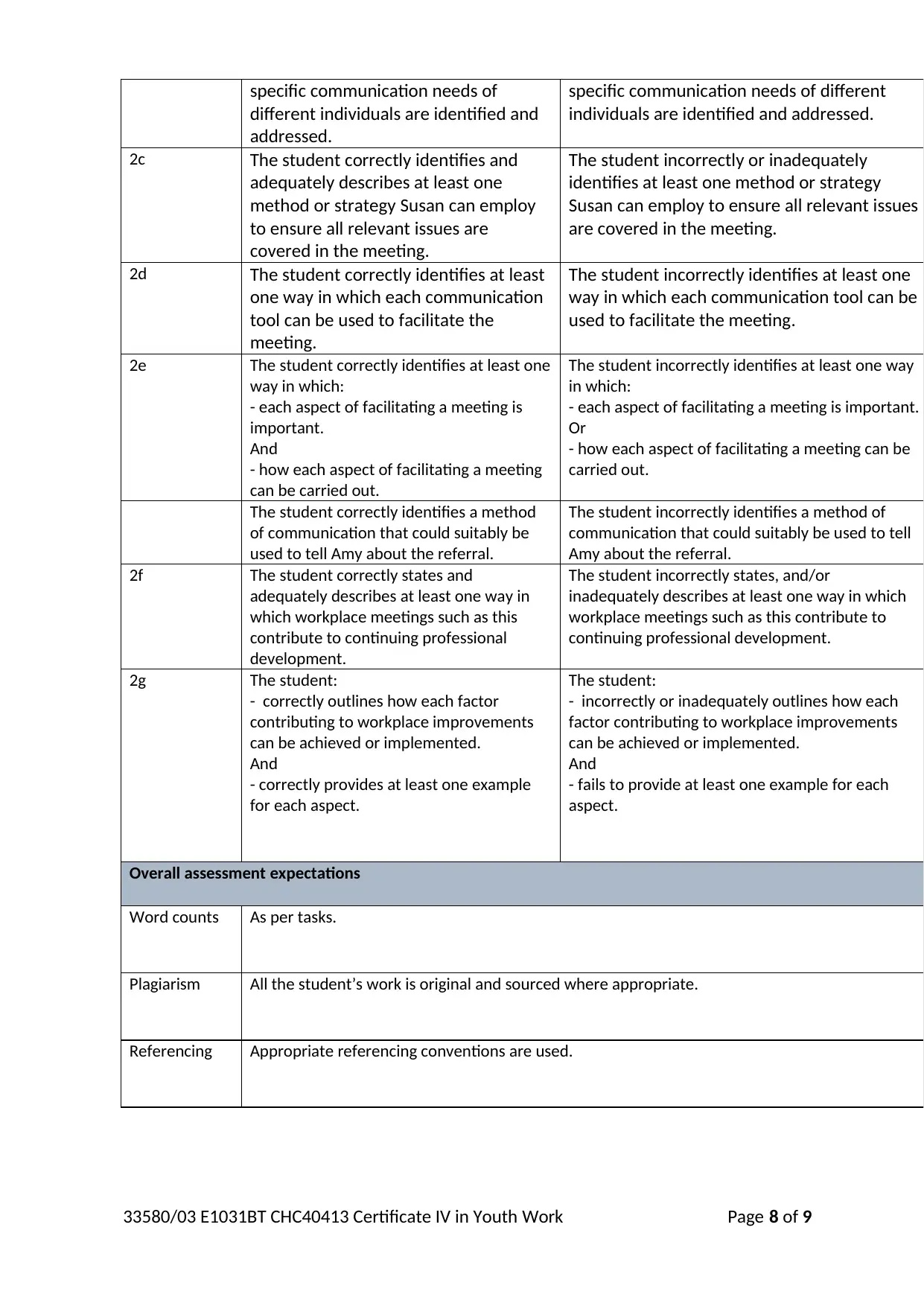
specific communication needs of
different individuals are identified and
addressed.
specific communication needs of different
individuals are identified and addressed.
2c The student correctly identifies and
adequately describes at least one
method or strategy Susan can employ
to ensure all relevant issues are
covered in the meeting.
The student incorrectly or inadequately
identifies at least one method or strategy
Susan can employ to ensure all relevant issues
are covered in the meeting.
2d The student correctly identifies at least
one way in which each communication
tool can be used to facilitate the
meeting.
The student incorrectly identifies at least one
way in which each communication tool can be
used to facilitate the meeting.
2e The student correctly identifies at least one
way in which:
- each aspect of facilitating a meeting is
important.
And
- how each aspect of facilitating a meeting
can be carried out.
The student incorrectly identifies at least one way
in which:
- each aspect of facilitating a meeting is important.
Or
- how each aspect of facilitating a meeting can be
carried out.
The student correctly identifies a method
of communication that could suitably be
used to tell Amy about the referral.
The student incorrectly identifies a method of
communication that could suitably be used to tell
Amy about the referral.
2f The student correctly states and
adequately describes at least one way in
which workplace meetings such as this
contribute to continuing professional
development.
The student incorrectly states, and/or
inadequately describes at least one way in which
workplace meetings such as this contribute to
continuing professional development.
2g The student:
- correctly outlines how each factor
contributing to workplace improvements
can be achieved or implemented.
And
- correctly provides at least one example
for each aspect.
The student:
- incorrectly or inadequately outlines how each
factor contributing to workplace improvements
can be achieved or implemented.
And
- fails to provide at least one example for each
aspect.
Overall assessment expectations
Word counts As per tasks.
Plagiarism All the student’s work is original and sourced where appropriate.
Referencing Appropriate referencing conventions are used.
33580/03 E1031BT CHC40413 Certificate IV in Youth Work Page 8 of 9
different individuals are identified and
addressed.
specific communication needs of different
individuals are identified and addressed.
2c The student correctly identifies and
adequately describes at least one
method or strategy Susan can employ
to ensure all relevant issues are
covered in the meeting.
The student incorrectly or inadequately
identifies at least one method or strategy
Susan can employ to ensure all relevant issues
are covered in the meeting.
2d The student correctly identifies at least
one way in which each communication
tool can be used to facilitate the
meeting.
The student incorrectly identifies at least one
way in which each communication tool can be
used to facilitate the meeting.
2e The student correctly identifies at least one
way in which:
- each aspect of facilitating a meeting is
important.
And
- how each aspect of facilitating a meeting
can be carried out.
The student incorrectly identifies at least one way
in which:
- each aspect of facilitating a meeting is important.
Or
- how each aspect of facilitating a meeting can be
carried out.
The student correctly identifies a method
of communication that could suitably be
used to tell Amy about the referral.
The student incorrectly identifies a method of
communication that could suitably be used to tell
Amy about the referral.
2f The student correctly states and
adequately describes at least one way in
which workplace meetings such as this
contribute to continuing professional
development.
The student incorrectly states, and/or
inadequately describes at least one way in which
workplace meetings such as this contribute to
continuing professional development.
2g The student:
- correctly outlines how each factor
contributing to workplace improvements
can be achieved or implemented.
And
- correctly provides at least one example
for each aspect.
The student:
- incorrectly or inadequately outlines how each
factor contributing to workplace improvements
can be achieved or implemented.
And
- fails to provide at least one example for each
aspect.
Overall assessment expectations
Word counts As per tasks.
Plagiarism All the student’s work is original and sourced where appropriate.
Referencing Appropriate referencing conventions are used.
33580/03 E1031BT CHC40413 Certificate IV in Youth Work Page 8 of 9
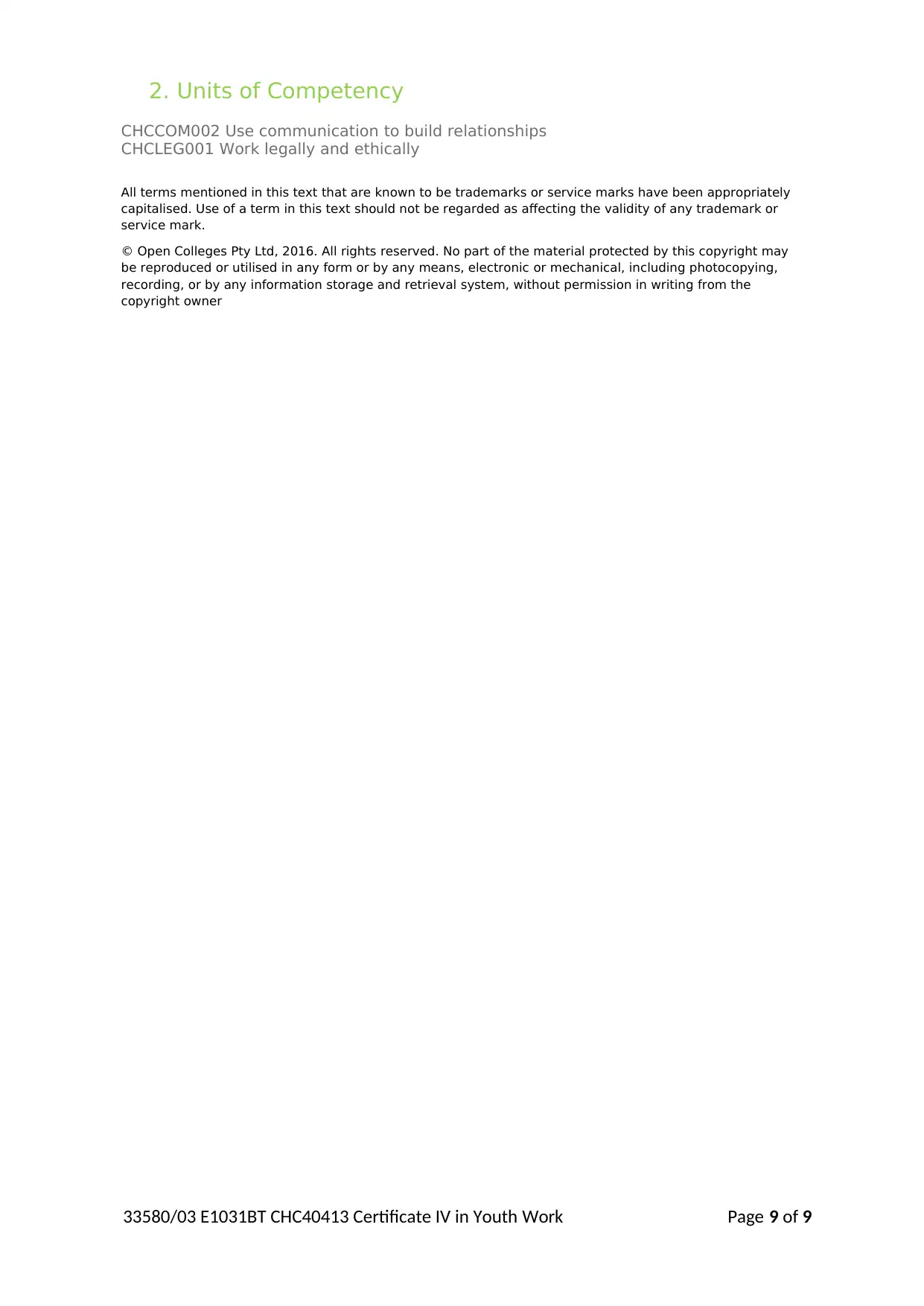
2. Units of Competency
CHCCOM002 Use communication to build relationships
CHCLEG001 Work legally and ethically
All terms mentioned in this text that are known to be trademarks or service marks have been appropriately
capitalised. Use of a term in this text should not be regarded as affecting the validity of any trademark or
service mark.
© Open Colleges Pty Ltd, 2016. All rights reserved. No part of the material protected by this copyright may
be reproduced or utilised in any form or by any means, electronic or mechanical, including photocopying,
recording, or by any information storage and retrieval system, without permission in writing from the
copyright owner
33580/03 E1031BT CHC40413 Certificate IV in Youth Work Page 9 of 9
CHCCOM002 Use communication to build relationships
CHCLEG001 Work legally and ethically
All terms mentioned in this text that are known to be trademarks or service marks have been appropriately
capitalised. Use of a term in this text should not be regarded as affecting the validity of any trademark or
service mark.
© Open Colleges Pty Ltd, 2016. All rights reserved. No part of the material protected by this copyright may
be reproduced or utilised in any form or by any means, electronic or mechanical, including photocopying,
recording, or by any information storage and retrieval system, without permission in writing from the
copyright owner
33580/03 E1031BT CHC40413 Certificate IV in Youth Work Page 9 of 9
1 out of 9
Related Documents
Your All-in-One AI-Powered Toolkit for Academic Success.
+13062052269
info@desklib.com
Available 24*7 on WhatsApp / Email
![[object Object]](/_next/static/media/star-bottom.7253800d.svg)
Unlock your academic potential
© 2024 | Zucol Services PVT LTD | All rights reserved.





